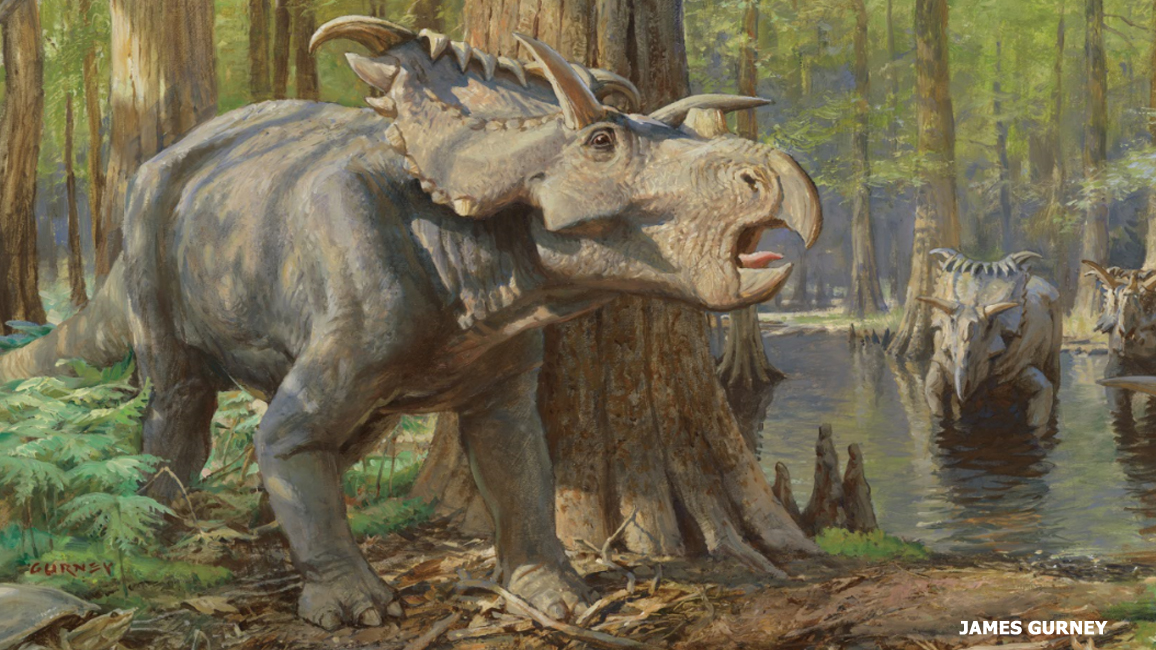
What’s New in the Past?
By Kathy Kranking; Art by James GurneyDig in and check out these latest dinosaur discoveries.

Ever since the first Jurassic Park movie came out in the 1990s, people have gotten really interested in dinosaurs. In the last 30 years, the number of paleontologists (pay-lee-on-TAHL-uh-justs), or scientists who study dinosaurs, has quadrupled! With so many people looking for dinosaur bones, lots of discoveries are being made.
The bones are preserved as fossils inside layers of rock. About 50 new dino species are found each year—that’s nearly one a week! The bones are out there, just waiting for someone to dig them up!
Baby Giant
Lived 80 million years ago
Discovered in Argentina
Scientists know for sure that dinosaurs laid eggs. They have found many dino egg fossils, even some with bones of baby dinosaurs inside them. Unfortunately, these tiny bones are very delicate. And after being buried in rock for millions of years, they’re usually so squashed that it’s hard to tell what they originally looked like. But now a perfectly preserved baby dino skull has been discovered! The skull is only about the size of a grape. It belonged to a baby titanosaur (see the adult titanosaurs on the next page). By studying it, scientists found that the baby had forward-facing eyes, unlike the adults, which had eyes that faced to the sides. And on its snout, it had a small horn!
Humongous Find
(Patagotitan mayorum)
Lived 95–100 million years ago
Discovered in Argentina
Gigantic titanosaurs were like long-necked prehistoric cows, spending their days peacefully grazing on plants. Now scientists have unearthed the most complete skeleton ever found of a giant titanosaur. And it’s a brand-new species! This dinosaur is one of the largest animals that ever lived. It was longer than a blue whale and heavier than 10 African elephants. Its thighbone alone was 2 feet taller than any of the people who dug it up. But as big as the gigantic dino was, scientists studying its bones think it may not have even been fully grown!

Dino Mummy?
(Borealopelta markmitchelli)
Lived 110 million years ago
Discovered in Canada
Millions of years ago, an armored dinosaur called a nodosaur (NOH-duh-sor) ate its last meal. Then, for some reason, the nodosaur died. And after millions of years, scientists dug up its fossilized body. This turned out to be an amazing discovery. With most fossils, bones are all that’s left of an animal. But this nodosaur’s skin and spiky armor were all well preserved. And instead of being squished or flattened, the body was still in its original shape. It looked very much as it would have looked when the dino was alive. And as a bonus, that last meal—ferns and other plants—was perfectly preserved, as well!
River Monster
(Spinosaurus aegyptiacus)
Lived 90–100 million years ago
Discovered in Morocco, North Africa
Dinosaurs certainly ruled on land. But scientists have long wondered whether any dinos were swimmers. The few fossils found of Spinosaurus—possibly the
biggest meat-eating dinosaur—hinted it could have lived in rivers. For example, its teeth were similar to a crocodile’s, good for catching slippery fish. And its feet were flat and paddle-like. But did it actually swim? Now a new discovery seems to give the answer: Fossils of Spinosaurus’s tail show it was paddle-shaped, like a giant fin. It’s the best evidence yet that this dino could swim and probably spent most of its life in the water.

Long-Lost Cousin
(Thanatotheristes degrootorum)
Lived 79 million years ago
Discovered in Canada
Tyrannosaurs, such as T. rex, were famously fierce. Razor-sharp teeth and strong jaws made them super predators. Now a new tyrannosaur has been discovered that lived 12 million years earlier than its bigger cousin, T. rex. The new dino, nicknamed “the reaper of death,” preyed on plant-eating dinos with its nearly three-inch-long teeth. A set of the fossil jaws of this dino sat in a museum drawer for 10 years, until someone finally studied them and realized they were from a fierce new species!
Handsome Horns
(Kosmoceratops richardsoni)
Lived 76 million years ago
Discovered in Utah
Scientists have discovered a number of dinosaurs that had fancy horns and spikes. But Kosmoceratops was probably the most amazing of them all. It had a frill with 10 horns on top of its head. It also had a horn above each eye, a ridge-shaped horn on its nose, and a horn coming out of each cheek! Scientists think the horns may have been to attract mates.
















